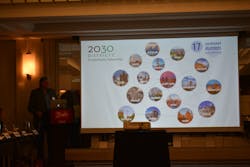Danfoss Symposium Explores Transformational Building Delivery
Leaders from the HVACR and buildings, policy, research and education, and energy-efficiency communities discussed how high-performance buildings can be delivered at the pace, precision, and volume required to transform the buildings marketplace as part of Danfoss’ 29th EnVisioneering Symposium, “Building Delivery: The Nexus of Market Transformation,” held recently in Washington, D.C.
“The industry has had broad discussion lately about the shift from building-component improvements to holistic or system strategies in the pursuit of the next level of energy efficiency, but another shift is occurring: from performance understood as energy efficiency to performance understood more comprehensively,” Lisa Tryson, director of corporate communications and public relations for Danfoss, said in her opening remarks. “Energy performance is essential, but economic growth, air quality, life experience within the building, life-cycle cost, and resource utilization are all critical themes now entering the equation.”
Driving the High-Performance Decision-Making Process
Over the next 15 years, U.S. urban population growth is expected to exceed total population growth, signaling a dramatic increase in demand on and for buildings. At the same time, 533 cities worldwide are now reporting greenhouse-gas (GHG) emissions, an increase of 70 percent since the Paris climate agreement was signed in late 2015.
According to Edward Mazria, founder and chief executive officer of Architecture 2030, the United States has leveled out building-sector energy consumption, but not yet significantly decreased it. He then laid out a three-pronged solution for reaching existing zero-net-carbon targets that includes the use of high-performance design in new buildings, deep energy retrofits in existing buildings, and renewable energy via incentives for buildings unable to implement deep energy retrofits.
“We need to dispel the myth that high-performance buildings are more expensive to design and build,” Mazria said. “In new buildings, it’s possible to find easy tradeoffs in design that make energy efficiency very affordable. And in existing buildings, energy-efficiency improvements cost approximately 75 percent less when undertaken at a building’s intervention point or major renovation.
“For this to work,” Mazria proclaimed, “bottom-up leadership is absolutely critical and goes hand-in-hand with better education of the buildings sector and academia.”
A market-optimized policy, whereby advanced codes are adopted on the local level, also is necessary. Mazria cited cities such as Palo Alto, Calif., and Santa Monica, Calif., which have started to improve commercial and residential building codes, respectively.
Richard Swett, co-founder and chief executive officer of Climate Prosperity Enterprise Solutions and former U.S. ambassador to Denmark, noted the key to energy-performance decisions lies within benchmarking.
“We need measurable ways of monitoring and reporting,” Swett stated. “We need to be able to capture the ‘big data’ within buildings in order to review, analyze, and improve. Historically, buildings were not built to be machines. But that is changing.”
Swett laid out the blueprint for a collaborative building-modeling tool that compiles in one platform the functionalities of several existing tools and would enable architects, engineers, owners, and any other stakeholder to manage and verify everything from building programming and design to construction and operations.
“Changing minds is affected by the ability to show trends and prove opportunities,” Swett remarked.
Best Practices in Transformation
Changing the market and proving opportunity is just part of the results of Vancouver’s green-building program, according to Sean Pander, who serves as the city’s green-building program manager.
“The city’s goal is to lead the world in green-building design and construction,” Pander explained.
Vancouver employs a strategy that dictates 100 percent of energy originate from renewable sources by 2050. Additionally, all new buildings are required to have zero operational GHG emissions by 2030—or earlier.
Vancouver’s Zero Emissions Building Plan includes incentives for private-sector leaders striving to reach zero-emissions buildings and investment in tools to improve knowledge sharing and remove barriers. Passive-house certification is sought for all new city-owned buildings.
Passive house, according to Tomás O’Leary, co-founder and managing director of Passive House Academy, is the easiest path to nearly net-zero carbon emissions.
“Compared to a conventional building, a passive-house building uses up to 75 percent less total energy,” Brandon Nicholson, founding principal of Nicholson Kovalchick Architects, explained.
According to Nicholson, who has built a business model around this integrated design principle, the performance of these buildings is predictable and the results certain. The buildings are durable, comfortable, and healthy. Therefore, they represent superior value, can command better prices/rents, have lower vacancy rates and utility bills, and require less maintenance and equipment replacement. And they can be delivered at “near-first-cost parity.”
The keys to achieving first-cost parity, Nicholson said, include design expertise, knowledgeable tradespeople, component economies of scale, and a locally based supply chain.
To download the full symposium report, click here.

